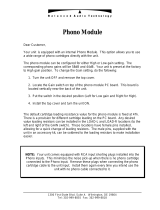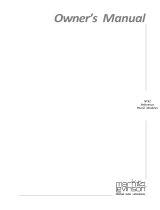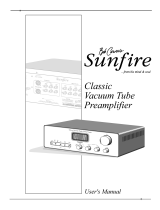Page is loading ...


2
“
I am surprised to be sitting here writing an
owner’s manual for the PHONO LOCO. It seems
so official. The PHONO LOCO has made the
journey from an unlikely experiment to a solid
product. Most of this time, I was telling myself
‘the LOCO is unmarketable’. BUT—tossing aside
marketability is an amazing freedom.
— RON SUTHERLAND

3
The initial prototype listening was so emotionally rich. It kicked
in a stubborn determination to perfect the full performance
possibilities. That’s when the project truly went loco. With
performance as the arbiter of each design decision, the PHONO
LOCO was steadfastly focused on delivering a seductive listening
experience.
The PHONO LOCO was never designed or built to be a commodity.
It has taken on a life and personality of it’s own.

4
— A Bit of History —

5
Sutherland has been making phono preamps for a good long
time. By focusing almost exclusively on phono preamps, our
design and circuitry has benefited from continued refinement and
improvement over the years. All of those designs were based upon
voltage amplification.
The cartridge delivers a small voltage to the phono preamp input.
This voltage is then multiplied to create a larger output voltage
(along with RIAA EQ). A typical voltage multiplier of 1,000 can also
be expressed as 60 dB.
One millivolt in → one volt out.

6
You may have also noticed a new kind of phono preamp design—
usually referred to as ‘current input’. Until recently, that approach
has been very much in the background. But, listeners and
reviewers are now giving it some serious consideration. And many
love what they hear.
Current Input
The input signal comes from the current flowing through the
cartridge, NOT the voltage from the cartridge. That current
information is the input for a transimpedance gain stage. I.e. the
input signal is current and the output signal is voltage.

7
— LINKING INTO YOUR SYSTEM —

8
At first glance, the connections on the back panel of the PHONO LOCO appear totally conven-
tional. There is the usual IEC input for the AC power cord, and a ground screw for grounding
the turntable. The RCA jacks deliver an output signal to your line-level preamp. Closer exam-
ination shows them to be WBT nextgen with Pure Fine Silver contacts—an unusually expen-
sive choice that is rarely seen on preamps at even the most elevated price.
The big surprise…signal input connections are with XLR connectors. To optimize performance,
the input stage requires a floating connection to both cartridge coil terminals. There must be
no direct connection from either coil side to chassis ground.
XLR pin assignments are as follows:
Pin #1: overall cable shield
Pin #2: to coil +
Pin #3: to coil –
For information on using the included RCA to XLR adapter, see Appendix A.
For information on connection to turntables with built in RCA jacks, see Appendix B.

9
Load Settings
There are no loading adjustments in the PHONO LOCO. Your cartridge will see a load of zero
Ohms. The input signal will be the current your cartridge produces into that virtual short. No
need to worry about or fuss around with loading.
Gain Settings
Your PHONO LOCO is factory–set to medium gain. That should work very well in most situ-
ations. The usual concerns about cartridge output voltage do not apply here. Cartridges of
varied output voltage specs tend to supply about the same level of drive current into a short.
I.e. higher output voltages usually have higher resistance while lower output voltages usually
have lower resistance. Into a virtual short, most deliver about the same current signal.
If your particular situation would benefit
from a gain adjustment, you can change
it. Inside, on the red circuit boards, you
will see a place for gain setting resistors.
The PHONO LOCO ships with 3k resistors
installed for medium gain. You can boost
the output voltage 6dB by removing
those resistors. Or, you can reduce the
output voltage 6dB by replacing the 3k
resistors with 1k counterparts.
No matter which gain you select, all
four installed resistors must be the same
value.

10
Size
17” wide
17” deep
3.25” high
Shipping Box
24” wide
24” deep
11” high
Contact Info
Sutherland Engineering, Inc.
455 East 79th Terrace
Kansas City, MO 64131
Phone: +1 (816) 718-7898
Email: ron@sutherlandengineering.com
Website: www.sutherlandengineering.com
Weight
Unit Weight: 21lbs
Shipping Weight: 26lbs
Operating Voltage Requirements
105 — 125 VAC, 12 watts
210 — 250 VAC units are available on special
order
Note: operating voltage is NOT universal and
cannot be field modified.
Warranty
5 years parts and labor. Transferable. Only
valid for units that have not been modified
or abused.

11
—
Appendix A
—
Using the Included RCA to XLR Adapters
Two special RCA to XLR adapters are included in the accessory box. Most turntable/arm
cables terminate with an RCA plug. In most cases, using the adapters will be plug and play.
The typical, best practices for TT to preamp interconnects will work just fine. That is: the coil
+ and coil – signals are conveyed to the RCA plug via a shielded twisted pair. The coil + goes
to the RCA center pin and the coil – goes to the RCA shell. There is an overall shield that is
NOT connected at all to the RCA plug. The shield has it’s own ground wire that will go to the
PHONO LOCO chassis ground screw.
For best performance, you will want to invest in XLR terminated cabling. For many arms,
that cable would have a DIN socket at the arm end with two XLR plugs at the preamp end.
And probably a separate ground wire.
There may be a temptation to upgrade from the supplied adapters to something more luxuri-
ously adorned with gold. That is unlikely to work. Most all such adapters have pin #3 and pin
#1 internally connected. Thus the requirement that both pin #2 and pin #3 float with respect
to ground is not met.

12
—
Appendix B
—
Connecting to Turntables with Built-In RCA Jacks
Two cables will be required. Each will be a twisted pair with an overall shield. The twisted
pair will convey the signal. The RCA center pin will go to the XLR #2 pin. The RCA shell will go
to the XLR #3 pin. The overall shield will ONLY go to XLR pin #1. The shield MUST NOT con-
nect to anything at the RCA end.
Your dealer will help you with this. Most of the time it is just plug and play. If your situation is
different, don’t worry. We will get you taken care of. There is a strict requirement that both
signal lines float with respect to ground. With that met, you are all set to go.
/



